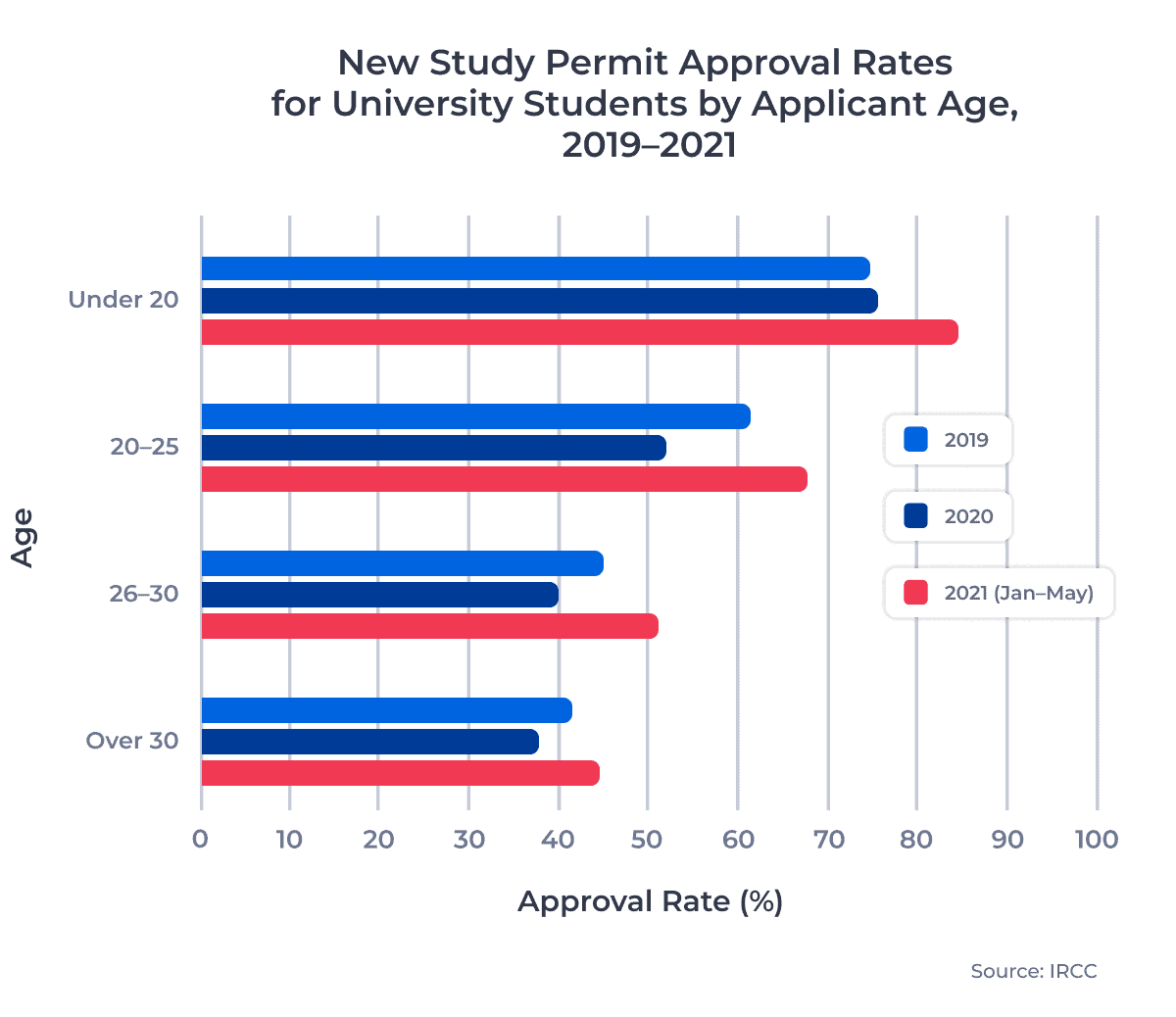The recovery of Canada’s post-secondary sector is well underway even as the pandemic stretches on. Nearly 120,000 new post-secondary1 student visas2 were approved by the end of May 2021, a 25% increase over all of 2020.3 If this rate continues, approved study permit volumes for 2021 could approach 2019 numbers. Remarkably, this strong recovery is primarily due to growing older student populations.
Last year, when I dug into the relationship between study permit approval rates and applicant age, I found that older applicants experienced lower approval rates. As the pandemic has caused significant shifts in approval rates, I’m going to revisit applicant age approval data in today’s ApplyInsights.
I’ll analyze how post-secondary approval rates for younger and older applicants have shifted over the past five years, and I’ll compare age-based approval rates for college and university students. I’ll also dive deeper into study permit volumes by applicant age before providing my thoughts on how these trends will continue in 2021 and 2022.
Key Insights at a Glance
- New Canadian study permit approval rates were 30 to 40 percentage points higher for applicants under 20 compared to those over 30 from January 2016 to May 2021.
- College study permit approval rates for 25 to30 year olds rose nearly 15 percentage points from 2016 through early 2021.
- International students aged 25+ accounted for over 30% of new study permit applications between January and May 2021, up from 24% in 2016.
We’ll start by looking at study permit approval rates by applicant age for all study levels from 2016 through to May 2021.
Post-Secondary Study Permit Approval Rate by Applicant Age
Younger international post-secondary students have consistently seen higher study permit approval rates over the last five years. The strong negative correlation between study permit approval rate and applicant age is especially evident when looking at the oldest and youngest age categories. In every year from 2016 to 2020, students under 20 were nearly twice as likely to have their study permit approved as students over 30.
The chart below compares the study permit approval rate for new post-secondary students across four age brackets:
I was surprised to see that during the pandemic, students aged 20 to 25 experienced the biggest shift in approval rate. They were the only age group to see their approval rate decline more than 10 percentage points, falling from 58% in 2019 to 47% in 2020. This marked the only time from 2016 to early 2021 when the approval rate for 20 to 25 year olds dropped below the average approval rate for all age brackets.
While 2021 data is currently only available for January to May, some interesting trends have already emerged. Approval rates for all post-secondary students are up, but the gains are not equal in all age groups. Students aged 20 to 25 saw their approval rate rise 19 percentage points over full-year 2020, while students over 30 only experienced a 9 percentage point increase. The approval rate for students aged 26 to 30 hit a six-year high at 52%.
I anticipate that these approval rates will shift somewhat as the year progresses. But these high approval rates are great news for institutions and students who delayed their study abroad plans during the pandemic.
Approval Rates for College by Applicant Age
To see if these approval rate changes are consistent throughout the post-secondary sector, let’s take a closer look at approval rates for college students. College applicants have historically had lower approval rates. However, trends in early 2021 showed a major increase in college approval rates, which rose 24 percentage points from 2020 to April 2021.
The following chart shows the study permit approval rate for college applicants by age from January 2019 to May 2021:
However, older students also saw less of an approval rate rebound in early 2021. College students over 30 saw their approval rate climb 8.3 percentage points from 2019 through the first five months of 2021. By comparison, college students under 20 experienced an increase of 10.1 percentage points.
Approval Rates for University by Applicant Age
While university applicants have historically seen higher study permit approval rates, did the pandemic impact this trend? The chart below shows the study permit approval rate for university applicants by age from January 2019 to May 2021:
Significantly, from January through May 2021, students over 25 were more likely to be approved for a college study permit than a university study permit. These approval rate trends could have long-term impacts on recruitment strategies for Canadian colleges and universities. In 2019, 25% more mature students were accepted for college studies compared to university studies. In early 2021, this difference jumped up to 33%, showing that higher approval rates could be a factor driving older students towards Canadian college programs.
Growing Interest from Older International Students
In fact, the Canadian post-secondary market has already seen a shift in study level interests among older students. In 2016, around 41% of all applicants over 25 applied for college studies. By early 2021, nearly 52% of applications from students over 25 were for college programs.
Even taking into account different approval rates depending on student age and study level, the average age of Canada’s new international student population is increasing. The following charts show the market share of each age group for new post-secondary study permits approved in 2016 and between January and May 2021:
Older students were more likely to have better financial stability during the pandemic and were more likely to continue with their study abroad plans. But this older student trend was evident pre-pandemic. When I looked at this trend last year, I noted that the Iranian, Jamaican, Filipino, Brazilian, and Colombian markets were the top source markets for mature students for Canadian schools. However, many of these markets experienced large decreases in their study permit approval rates in 2020. As a result, these markets sent a smaller number of students to Canadian institutions in 2020 and early 2021.
Yet, mature student populations continued to grow. To determine which countries are driving this growth, I’ll be digging deeper into the top source market for mature students in the coming weeks.
Tips for Older Applicants
With more and more older international students looking to study in Canada, it’s helpful to understand why approval rates may be lower for older applicants. According to Hari Ghai, ApplyBoard’s Senior Immigration Consultant and a Regulated Canadian Immigration Consultant (RCIC), government officers often scrutinize older applicants more carefully.
Visa officers are looking for evidence that applicants are pursuing study-based permanent residency (PR) pathways because they are ineligible to enter Canada in other ways. Hari recommends that older students select their programs carefully and articulate a clear purpose for studying abroad to reassure visa officers that their interest in a Canadian education is genuine.
Students should aim to select a study path that shows obvious career progression by improving their credentials. For example, a visa officer would likely be more inclined to approve an applicant with a degree in health sciences looking to enroll in a Master of Nursing program compared to a similar student applying for a pre-health sciences certificate program.
Looking Forward
While there are many factors that a student can control which affect their study permit approval outcome, they can’t change their age. Students considering studying abroad should keep in mind that they are more likely to be approved at a younger age and that older students may be more closely scrutinized. However, older students may also have the benefit of improved financial stability.
I expect that the average age of international students coming to Canada will decline somewhat as younger students who delayed their study abroad plans return post-pandemic. But the mature student sector will likely continue to grow in the years to come. Canada’s permanent residency pathways, including the popular Post-Graduation Work Permit Program (PGWPP), will continue to attract mature students who want to increase their skills, advance their careers, and immigrate to Canada.
As approval rates shift post-pandemic, it’s more important than ever for Canadian institutions to recruit from diverse student populations, including more mature students. To reach students of all ages, I would encourage institutions to consider:
- Cross-publishing promotional materials through different communication channels
- Profiling young and mature international students in market materials to emphasize the institution’s success in meeting diverse student needs
- Providing information about local amenities, communities, and opportunities that appeal to different age groups such as on-campus housing for younger students and childcare facilities for mature students with families
Our recruitment partners are also likely to see larger populations of mature students looking to study abroad post-pandemic. To help those students pursue their educational dreams in Canada, recruitment partners should remember to:
- Select programs that clearly demonstrate career progression for older applicants
- Work with older students to create a unique letter of explanation that reassures visa officers that the student’s interest in a Canadian education is genuine
Published: August 18, 2021
Subscribe to ApplyInsights
Sign up for the latest insights on international education.
 Meti Basiri
Meti Basiri
Co-Founder and Chief Marketing Officer (CMO)
Meti is driven by the belief that education is a right, not a privilege. He leads the International Recruitment, Partner Relations, and Marketing teams at ApplyBoard, working to make education accessible to people around the world. Meti has been instrumental in building partnerships with 1,500+ educational institutions across Canada, the United States, the United Kingdom, and Australia. Working with over 7,500 international recruitment partners, ApplyBoard has assisted more than 200,000 students in their study abroad journey. Follow Meti on LinkedIn for more access to ApplyInsights and key industry trends.
FOOTNOTES:
1. For the purposes of this article, post-secondary includes all study levels beyond secondary school, including ESL/FSL and other language study programs.
2. The terms student visa and study permit are generally used interchangeably for Canadian international students. Rather than student visas, Canada provides accepted international students with study permits, which allow those students to enroll in classes at Canadian institutions. When a student is accepted for a study permit, they are also usually provided with a visitor visa, which allows that student to enter Canada for their studies.
3. Statistics used in this article are for new study permits only. All data courtesy of Immigration, Refugees and Citizenship Canada (IRCC), except where noted.



